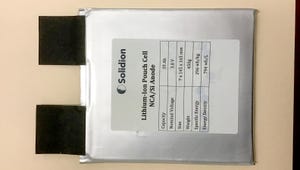"Why Nanowires?" – Insights from CEO of OneD Battery Sciences
Explore the transformative potential of nanowires in energy storage, as explained by CEO of OneD Battery Sciences.

In a recent YouTube interview, Dr. Vincent Pluvinage, the CEO of OneD Battery Sciences, engaged in a conversation with Tom Prucha, Director of Electrification at Munro & Associates, addressing various topics, including the question of "Why Nanowires?" In this insightful discussion, Pluvinage explains the significance of nanowires in energy storage.
Pluvinage begins by highlighting the battery industry's fundamental challenge: energy density. Conventional lithium-ion batteries rely on graphite anodes, which have limitations regarding capacity. Pluvinage emphasizes that nanowires are a compelling solution to this challenge. These ultra-thin structures, often just a few nanometers in diameter, enhance energy storage.
One of the key reasons nanowires are at the forefront of battery innovation is their compatibility with silicon anodes. Silicon has the potential to store up to ten times more lithium ions than graphite, promising a significant boost in energy density. However, silicon undergoes significant swelling as it absorbs lithium ions, which can lead to the degradation of the battery.
He points out that nanowires offer a neat solution to this issue. Their minuscule size provides more room to accommodate the swelling, preventing structural damage and extending the battery's lifespan. According to Pluvinage, there are three fundamental reasons for the unique properties and advantages of nanowires:
Precise Control of Diameter: The growth of nanowires involves using a catalyst, which allows for precise control over their diameter and is crucial for reducing production costs. The catalyst used is incredibly small, around 26 nanometers in diameter, and ensures rapid and efficient growth of nanowires.
Uniformity and Electrical Contact: Nanowires exhibit uniform diameters, and their roots are embedded into a graphene structure. This uniformity ensures that all the nanowires have similar dimensions, eliminating concerns about variations in size. Additionally, the roots of the nanowires in the graphene provide perfect electrical contact. This solves the issue of controlling the shape and size of the silicon, a significant advantage for battery technology.
Enhanced Surface Area: Nanowires have a significantly smaller surface area than an equivalent amount of silicon in the form of nanoparticles. This reduced surface area is an advantage for mitigating electrolyte-related challenges. He used an interesting analogy, using a thin spaghetti strand: Pluvinage said, "Imagine a long, thin spaghetti strand – the surface area corresponds to the ends of the spaghetti on both sides, while the cylindrical shape of the spaghetti is essentially the product of its circumference and length. This results in a specific volume and surface area. Now, envision this structure made of silicon instead of pasta. If you break this silicon 'spaghetti' into two pieces, you'd add a surface area in the middle on each side of the break, but the volume remains unchanged. Continuing to break it into four, then eight, and so on, you eventually create a collection of tiny particles, all with the same diameter as the original nanowire or 'spaghetti.' What emerges is a significantly larger surface area."
During the interview, Pluvinage emphasized that with more surface area available for lithium-ion interaction, nanowires facilitate ultra-fast charging, which has profound implications for electric vehicles (EVs) and renewable energy storage. EVs could be charged in minutes, making them far more practical and appealing to consumers.
Moreover, nanowires contribute to improvements in power density. Power density refers to the ability of a battery to deliver a high amount of energy in a short period. This aspect is crucial for applications like EVs, where quick bursts of power are essential for acceleration. Pluvinage notes that nanowires enable faster energy release, resulting in snappier acceleration in EVs and more efficient energy distribution.
However, Pluvinage acknowledged that integrating nanowires into mainstream battery production is challenging. The manufacturing process for these delicate structures involves complex techniques. These processes pose challenges for large-scale production, but he is optimistic about the future of nanowires in battery technology.
Pluvinage highlights the ongoing research efforts and collaborations within the industry aimed at optimizing nanowire production processes and reducing costs. As advancements continue, nanowires have the potential to transform the energy storage landscape, making batteries more efficient, affordable, and environmentally friendly. Nanowires are powerful structures that address critical limitations in energy density, charging speed, and power density. Researchers and innovators like Pluvinage are committed to harnessing the full potential of nanowires for a more sustainable and energy-efficient future.
About the Author(s)
You May Also Like





